You're using an outdated browser. Please upgrade to a modern browser for the best experience.
Please note this is a comparison between Version 2 by Mona Zou and Version 1 by Magnus de Witt.
The Antarctic is one of the last frontiers on Earth, and habitation and research in the region are challenging and dangerous owing to its harsh environmental conditions. The provision of sufficient infrastructure to researchers engaged in seasonal or year-round research in the Antarctic is essential. Energy is a crucial element of supportive infrastructure, needed to support space heating—required in living areas to prevent sensitive areas from freezing—electricity, water treatment, and fresh-water generation.
- Antarctica
- renewable energy
- remote energy
- energy resources
1. Mapping the Current Energy Situation
Antarctica is the only non-inhabited continent on Earth [2][1]. However, several traces of temporary human habitation dating back to the 19th century have been found there [15][2]. Today, research stations constitute the only human traces on Antarctica, as no military stations may be found there, in accordance with the Antarctic Treaty, leading some to dub Antarctica the “land of research” [3,16][3][4]. This study identified 81 research stations, which may be classified into two categories: year-round and seasonally operated stations. Fossil fuels constitute the continent’s predominant energy source. As Figure 21 illustrates, 37 research stations currently use renewables, but the data suggest that the proportion of renewable energy used is often low. Over time, however, different renewable-energy sources have been tested and integrated into research stations’ energy supply. Figure 32 highlights key milestones in the use of renewable energy in Antarctica.
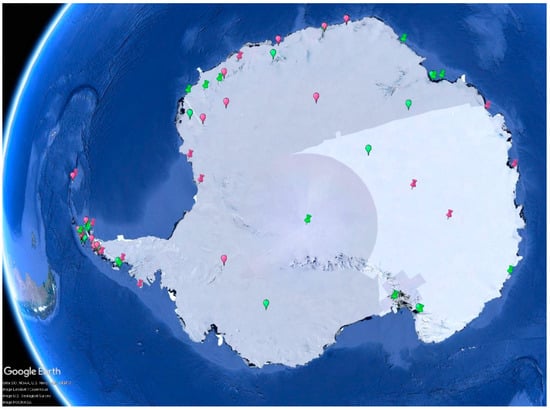
Figure 21. This figure illustrates the different energy sources used at research stations in Antarctica. The green pins represent year-round stations with experience in using renewables. The red pins represent year-round stations without experience in using renewables. The green bubbles represent seasonal stations with experience in using renewables. The red bubbles represent seasonal stations without experience in using renewables.
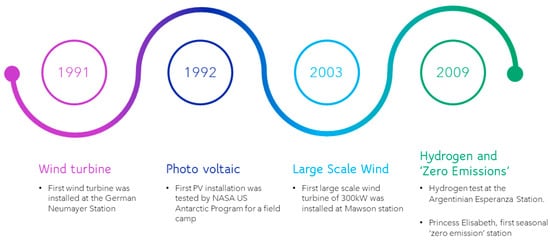
Figure 32. This figure highlights the milestones in the development of renewable energy in Antacrtica. The start of testing renewable-energy sources such as wind and PV started in the early 1990s, followed by a second phase in the 2000s with the deployment of larger scale renewables and testing new technologies under Antarctica conditions.
Even those research stations that use a relatively high proportion of renewable energy use diesel generators as backup power sources. The combination of one or more renewable-energy sources with a diesel generator is known as a hybrid system [17][5]. In Antarctica, the renewable-energy sources used in hybrid systems are wind or solar power, both of which are non-dispatchable. The use of non-dispatchable energy sources may be problematic, owing to potential rapid shifts in energy output in response to weather fluctuations [18][6]. These rapid changes may cause fluctuations in power supply with respect to voltage and frequency when the proportion of renewable energy used is high [19][7]. When the share of renewables used is low, the diesel generator can stabilize voltage and frequency in the grid [20][8].
Grid-forming devices are typically used to even out fluctuations in systems with a high percentage of renewables, where grid-forming devices are needed. For example, at Princess Elisabeth Station, which has a high penetration of renewables (as Figure 32 illustrates), a battery system is used to stabilize the electricity grid [9]. The provision of high-quality electrical batteries can help even out discrepancies in supply and demand. The battery can help to shift electricity from times where more electricity is generated than used to a time of electricity shortage. The battery’s size determines the amount of energy that can be shifted to address shortages. Batteries have low self-discharge, ranging from 0.05 to 5% per day, depending on type [21][10]. Energy storage is essential in attaining high renewable usage, given that weather conditions sometimes do not allow high shares of renewables to be harvested. Batteries are capable of storing energy for a relatively short period, ranging from several hours to a few days [22,23][11][12]. As a form of intermittent energy storage in a high-penetration system, a battery may be sufficient for a seasonal research station.
Energy Consumption
For an islanded energy system with non-dispatchable energy sources, it is important to analyze demand to facilitate high usage of the available energy. This analysis should focus on large energy consumers. The literature and inquiries show that large consumers are related to processes where heat is generated, such as a water supply [24,25][13][14]. To optimize the use of the generated non-dispatchable energy, it is necessary to evaluate whether major energy consumers may be used as flexible loads in the case of high energy generation from non-dispatchable sources. If the major consumers can be used as flexible loads, they may replace the dump load if energy generation exceeds demand [24][13]. The generated energy is converted to another energy form and stored. For example, surplus energy may be used to melt ice or snow to produce fresh water for later use, or a hot-tap water-storage tank may be overheated (according to specifications) as a means of storing energy. All these methods depend on how much extra energy can be stored. It is important to find flexible consumers to allow the system to operate as efficiently as possible. Overall, it can be seen that during the Antarctic winter the energy demand is highest, even when the population of a station is the lowest. The energy demand for Jang Bogo Station and King Sejong Station is shown in Figure 43 as primary fuel demand.
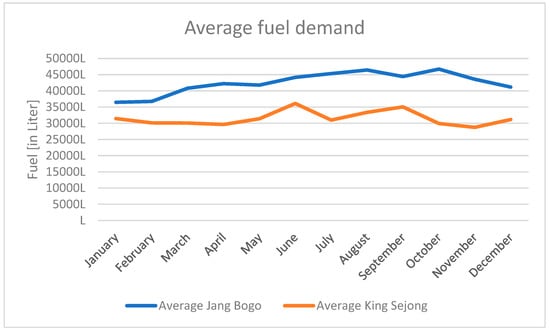
Figure 43.
This figure shows the average fuel demand from 2018–2023 for Jang Bogo Station and King Sejong Station.
2. Available Renewable-Energy Sources
The use of wind energy in Antarctica can be challenging, due to the extreme climatic conditions; the annual mean temperature can be as low as −50 °C on the inland plateau [5][15]. The lowest temperature on Earth, measured at −89.2 °C, was recorded at Vostok Station in July 1983 [5,26][15][16]. The wind can reach particularly high speeds in coastal areas, and the highest wind speed in Antarctica—327 km/h—was measured at Dumont d’Urville Station in July 1972 [26][16]. On the inland plateau, the wind is relatively mild, and the highest wind speed at the South Pole was 93 km/h in September 2011 [26][16]. Global horizontal solar radiation peaked in December, reaching 300 W/m² [24][13]. Comparison with South Korea (Seoul) shows an annual average global horizontal radiation of approximately 3.9 kWh/m², with an annual average global horizontal radiation of 2.87 kWh/m² in Antarctica (SANAE IV Station) [24,27][13][17]. This demonstrates that solar potential is an exciting option, despite its seasonal availability. According to some observations, wind and solar power may be used as wholly complementary energy sources [1][18].
2.1. PV
2.1.1. Introduction
Solar power harvesting in Antarctica started in the early 1990s, when NASA and the US Antarctic Program tested PV at a field camp to generate electricity [7][19]. Since then, the collected data have revealed that the installed capacity has increased to over 220 kWp nowadays. The current largest PV installation identified in this study is at the Italian Mario Zucchelli Station, with an installed capacity of 62 kWp [28][20].
2.1.2. Solar Conditions
Solar power does not always appear applicable in high latitudes, due to seasonality. However, harsh, cold conditions also positively affect electricity generation with PV cells. Low temperatures can increase the efficiency of PV cells [4,29,30][21][22][23]. The power output increases by 0.35–0.5% per Kelvin, compared to the standard testing temperature [31][24]. Moreover, snow reflects solar radiation, which increases the yield of electricity generation [1][18]. Observations from weather stations indicate that PV installations can contribute significantly to the electricity mix during the Antarctic summer, as Figure 54 illustrates. From October till the end of February, the solar potential is significant, which makes solar energy particularly interesting in terms of seasonal use.
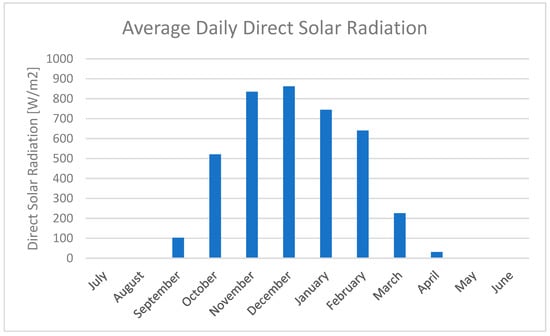
Figure 54. This figure shows the potential for PV installations from October till the end of February. The graph is based on weather measurements at Concordia Station.
2.1.3. Technical Problems and Solutions
The harsh environmental conditions can also exert a negative impact on PV infrastructure. Wind may cause snow to accumulate in front of the PV panel and eventually cover it [3,6,31][3][24][25]. PV panels are often mounted on walls to avoid snow accumulation and coverage. Walls are suitable because, in high latitudes, a high angle is preferred so that the solar radiation hits the panel from an optimal angle [31][24]. Moreover, the steep angle allows the snow to glide down. PV panels mounted on walls can be elevated from the ground to reduce the impact of near-surface flying parts. At Gondwana Station, little precipitation was previously observed and the dry snow was quick to blow away. As such, snow coverage was less problematic [32][26]. Owing to climate change, however, Gondwana Station now experiences more wet snow or rain, which clings to the PV panels, which are mounted nearly horizontally on a roof [32][26]. Nevertheless, strong gusts can blast ice or gravel against the PV panel, shattering the protective glass [3]. Such shattering will lead to faster degradation of the PV panel, which reduces the panel’s yield.
At Jang Bogo Station during winter, an additional protective cover for the PV panels was used [33][27]. However, the protective cover did not withstand the impact of stones, and no additional winter protection was pursued [33][27]. Thicker and stronger panels that were less likely to shatter were used to replace the broken PV panels [33][27]. One possible solution to this might be the use of some additional protective glass coating to reinforce the glass. However, further research and development are needed in this regard.
At the seasonal Gregor Johann Mendel Station, the damage to the PV panel occurred during the wintertime. This may have been the result of snow accumulation and several phase transitions between water and ice, which may have led to high pressure [34][28].
During the summertime, Antarctica has long daylight hours, often coinciding with periods of high activity at research stations. To ensure a more uniform electricity generation with PV throughout the day, a PV arrangement with different orientations, ranging from east-facing to north-facing to west-facing PV arrays, may be used [1,35][18][29]. With three different orientations, each PV array peaks at a different time, allowing the generation of electricity over more hours per day. This arrangement, in combination with a small battery, makes it easier to achieve a high PV. The battery is used for peak shaving and for stabilizing voltage and frequency, like a spinning reserve [21][10]. The research indicates that PV works well as an energy source for Antarctica’s research stations.
2.2. Wind
2.2.1. Introduction
Wind-energy harvesting in Antarctica may have the potential to reduce fossil-fuel consumption considerably and alleviate dependence on fuel deliveries. One of the first wind turbines installed in Antarctica was the 20 kW wind turbine that was placed at Neumayer Station in 1991 [5][15]. The first large-scale wind turbine, with 300 kW, was installed at Mawson Station in 2003 [8][30]. Wind-energy use is becoming increasingly prevalent at Antarctica’s research stations. The present study identified more than ten research stations that have been using wind to generate electricity. The installed wind capacity, as identified by the study, is nearly 1500 kW of installed capacity. Their respective experiences of using wind energy differed, however, and will be elaborated on later.
2.2.2. Wind Conditions
Wind conditions in Antarctica are generally suitable for wind turbines. Sometimes, however, strong winds with high-speed gusts in combination with extremely low temperatures can be critical for wind turbines [16][4]. Some wind observations indicate that the wind in interior Antarctica is more constant on the coast, as in the case of the inland Concordia Base and the coastal Mawson Station [3]. The Japanese Syowa Base has recorded lower winter (July) wind speeds [25][14]. At the Brazilian Comandante Ferraz Station, it was observed that greater winds occur in late winter/springtime (June until October) [4][21]. In addition to the high wind speeds, the air density is higher due to the low temperatures [19][7]. According to the US Department of Energy, at −37 °C, an increased efficiency of 20% compared to temperate areas can be observed [19][7]. A simulation of the potential output of two different wind turbines is represented in Figure 65. The graph indicates that the generation is lowest during the Antarctic summer; the peaks are in spring and fall.
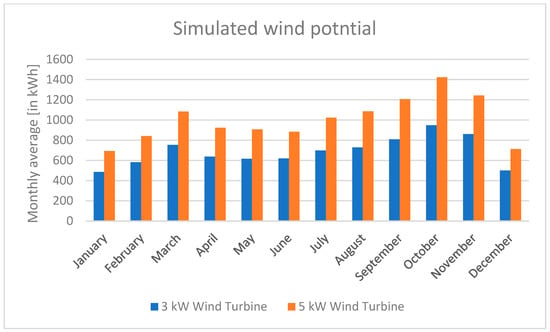
2.2.3. Technical Options in Use
Two main types of wind turbine may be found, both of which are used in Antarctica: horizontal-axis wind turbines (HAWTs) and vertical-axis wind turbines (VAWTs). VAWTs are typically used on a smaller scale, with a capacity below 100 kW [10][32]. HAWTs can be found in Antarctica in various sizes, from 1 kW up to several hundred kW.
HAWTs can be divided into those with a gear and those that are gearless. For cold-climate applications, gearless HAWTs are preferable, owing to their fewer parts, given that lubrication of the gearbox is problematic at extremely low temperatures [3,37][3][33]. This complexity may be exacerbated, depending on the HAWT’s size. Small HAWTs often have a passive yaw control, and the wind turbine is positioned into the wind, due to its geometry of the gondola or its exterior [36][31]. Larger HAWTs may have an active yaw control, whereby the yaw drives steer the nacelle into the wind [38][34].
Additional complexity may be added through pitch control, which positions the turbine’s blades [18,39,40][6][35][36]. A VAWT typically has just the rotor as a moving part, which reduces the complexity. VAWTs have several variations relating to different rotor designs. These can be grouped as lift and drag. The Savonius rotor design is a drag type, which has the capability to initiate the rotation from a still standing position, due to the force applied by the wind. The Savonius rotor is more solid, resulting in higher wind resistance. Several blade designs are available for the lift type, such as the Darrieus rotor, H-Darrieus, and the helical shape. The Darrieus blade design requires some external impulse to commence rotation. To overcome this, the VAWT often uses a combined Darrieus and Savonius rotor design. All VAWTs have an advantage in that they are able to handle omnidirectional wind and require no yaw control [40][36].
2.2.4. Construction Limitations
In addition to the technical difficulties associated with operating a wind turbine under the Antarctic’s harsh climatic conditions, technical limitations may also arise in relation to a construction project’s infrastructure. Construction projects in Antarctica must be well planned down to the last detail. All materials and tools needed for construction must be delivered or already in place [9]. If a single part or tool is missing—including parts as small as single bolts or screws—the entire construction project must be suspended until the next delivery arrives, which typically entails a delay of one year. Another potential limitation that must be considered when designing wind turbines for use in Antarctica is the construction machinery that is available. The type of crane that is available can limit the height of a wind turbine or the weight of its segments [3]. The wind turbine’s parts must fit on the local transportation infrastructure, such as sleds, which limits the segments’ dimensions, and odd sizes might be difficult to transport over long distances across ice [41][37].
2.2.5. Technical Problems and Solutions
The harsh climatic conditions with shallow temperatures harm oil and hydraulic seals and gearboxes [3]. The seals and gearboxes thus require close attention, generating high maintenance costs. Direct-driven wind turbines are preferred to reduce the impact of maintaining seals and gearboxes, as seen in Scott Base and Mawson [8,42,43][30][38][39]. Another issue related to cold weather conditions can be ice formation on the rotor blades [20,39][8][35]. Several solutions are available to prevent icing of the blades.
Anti-icing and de-icing solutions can be categorized into passive and active ice prevention. Passive ice prevention uses coatings or colors. For example, a Teflon coating will reduce the blade’s adhesiveness, making it more difficult for the ice to stick to the rotor blade [39][35]. Another passive method is to color the rotor blade black so that it will absorb the solar radiation required to heat it [44][40]. This has proven highly successful in the Arctic, but sunlight is required to heat the blades at very high latitudes. This method may be critical, given the long period of no daylight, which is suitable for low icing conditions. Without sunlight, however, the principle will not work.
Active icing-prevention methods include thermal, pneumatic, or impulse de-icing [39,45][35][41]. The active method requires some energy to measure, control, and operate the de-icing system, which can take approximately 2% to 12% of the nominative power [45][41]. Thermal de-icing uses electricity to heat the rotor blades and melt off the ice [39][35]. The process requires a small fraction of the generated electricity. It is essential that the blades be kept ice-free to ensure the turbine’s performance. Alternation of the blade profile would diminish the turbine’s efficiency [39,46][35][42].
Several problems thus arise in relation to snow and ice; indeed, the cold conditions generally exert a significant impact on the material properties. HAWT blades often encounter vibrations. This should be addressed during the design process by keeping the vibrations within the blade away from its natural frequency for the range of operation [47][43]. During the design phase, the blades’ natural frequency can be influenced by their length and weight. If the vibration within the blades reaches the blade’s natural frequency during operation, it may result in fractures or even the blade’s total collapse.
3. Energy Security
Energy security is vital for research stations in the Antarctic. Energy is required to support essential needs, such as heating, fresh-water supply, and electricity, which are critical for survival under harsh environmental conditions [1][18]. High-tech equipment is required to facilitate research, which necessitates a constant supply of high-quality electricity. Electricity quality entails that the voltage and frequency fluctuations should be within a defined tolerance range [51][44]. The provision of high-quality electricity falls under short-term energy security [52][45]. Short-term energy security describes the grid’s responsiveness to rapid change in either energy generation or energy consumption [19,52][7][45]. The responsiveness is critical in islanded energy grids, such as remote research stations.
This paper identified wind and PV as potential renewable-energy sources; both sources are non-dispatchable—that is, they cannot be regulated in terms of their performance [18][6]. In the case of low penetration of non-dispatchable energy sources in an islanded grid, the diesel generator can stabilize voltage and frequency [19][7]. In the case of high penetration with non-dispatchable energy sources, more sophisticated equipment is required to maintain voltage and frequency within the boundaries. Short-term energy security is essential for supporting experiments and research infrastructure.
Mid-term energy security, which focuses on a time horizon of several months to a year, is critical for survival [52][45]. The fuel-delivery process occurs within this timeframe. Without fuel, it can be critical to supply a remote research station in Antarctica with energy, underscoring the importance of the fuel-delivery process. If the share of renewables is sufficiently large, it may be possible to supply adequate energy to meet basic needs using renewables, provided grid-forming devices are operational.
References
- Antarctica. Available online: https://education.nationalgeographic.org/resource/antarctica/ (accessed on 17 August 2022).
- Pearson, M.; Zarankin, A.; Salerno, M.A. Exploring and exploiting Antarctica: The early human interactions. In Past Antarctica; Oliva, M., Ruiz-Fernández, J., Eds.; Academic Press: Cambridge, MA, USA, 2020.
- Boccaletti, C.; Di Felice, P.; Santini, E. Integration of renewable power systems in an Antarctica Research Station. Renew. Energy 2014, 62, 582–591.
- Aprea, J.L. Two years experience in hydrogen production and use in Hope bay, Antarctica. Int. J. Hydrogen Energy 2012, 37, 14773–14780.
- Boute, A. Off-grid renewable energy in remote Arctic areas: An analysis of the Russian Far East. Renew. Sustain. Energy Rev. 2016, 59, 1029–1037.
- Tester, J.W.; Drake, E.M.; Driscoll, M.J.; Golay, M.W.; Peters, W.A. Sustainable Energy—Choosing Among Options, 2nd ed.; MIT Press: Cambridge, MA, USA, 2012.
- Muhando, B.; Keith, K.; Holdmann, G. Power Electronics Review—Evaluation of the Ability of Inverters to Stabilize High-Penetration Wind-Diesel Systems in Diesel-Off Mode Using Simulated Components in a Test Bed Facility; Alaska Center for Energy and Power: Fairbanks, AK, USA, 2010.
- Baring-Gould, I.; Corbus, D. Status of Wind-Diesel Applications in Arctic Climates; National Renewable Energy Laboratory: Anchorage, AK, USA, 2007.
- Conti, J.P. In search of the zero-emission continent. Eng. Technol. 2009, 4, 46–49.
- Argyrou, M.C.; Christodoulides, P.; Kalogirou, S.A. Energy storage for electricity generation and related processes: Technologies appraisal and grid scale applications. Renew. Sustain. Energy Rev. 2018, 94, 804–821.
- Goede, A.P.H. CO2-neutral fuels. EPJ Web Conf. 2015, 98, 07002.
- World Energy Council. Energy Storage Monitor: Latest Trends in Energy Storage; World Energy Council: London, UK, 2019.
- Olivier, J.R.; Harms, T.M.; Esterhuyse, D.J. Technical and economic evaluation of the utilization of solar energy at South Africa’s SANAE IV base in Antarctica. Renew. Energy 2008, 33, 1073–1084.
- Obara, S.; Morizane, Y.; Morel, J. A study of small-scale energy networks of the Japanese Syowa Base in Antarctica by distributed engine generators. Appl. Energy 2013, 111, 113–128.
- Tin, T.; Sovacool, B.K.; Blake, D.; Magill, P.; El Naggar, S.; Lidstrom, S.; Ishizawa, K.; Berte, J. Energy efficiency and renewable energy under extreme conditions: Case studies from Antarctica. Renew. Energy 2010, 35, 1715–1723.
- Antarctic Weather. Available online: https://icecube.wisc.edu/pole/weather/ (accessed on 8 August 2022).
- Global Solar Atlas. Available online: https://globalsolaratlas.info/map?c=37.304918,126.663437,11&s=37.579957,127.00264&m=site (accessed on 16 August 2022).
- Wolf, P. Solar energy utilization in overall energy budget of the Johann Gregor Mendel Antarctic station during austral summer season. Czech Polar Rep. 2015, 5, 1–11.
- Kohout, L.L.; Merolla, A.; Colozza, A. A Solar Photovoltaic Power System for Use in Antarctica; NASA Technical Memorandum 106417; National Aeronautics and Space Administration: Cleveland, OH, USA, 1993.
- Pellegrino, F. Personal communication, 2022.
- de Christo, T.M.; Fardin, J.F.; Simonetti, D.S.L.; Encarnação, L.F.; de Alvarez, C.E. Design and analysis of hybrid energy systems: The Brazilian Antarctic Station case. Renew. Energy 2016, 88, 236–246.
- UiT. Available online: http://site.uit.no/canada2014/files/2014/09/CNNII_23SEP_1_8_Godtliebsen.pdf (accessed on 3 September 2018).
- Mussard, M. Solar energy under cold climatic conditions: A review. Renew. Sustain. Energy Rev. 2017, 74, 733–745.
- Frimannslund, I.; Thiis, T.; Aalberg, A.; Thorud, B. Polar solar power plants—Investigating the potential and the design challenges. Sol. Energy 2021, 224, 35–42.
- Prošek, P.; Barták, M.; Láska, K.; Suchánek, A.; Hájek, J.; Kapler, P. Facilities of J. G. Mendel Antarctic station: Technical and technological solutions with a special respect to energy sources. Czech Polar Rep. 2013, 3, 38–57.
- Goldmann, J.-F. Personal communication, 2022.
- Choi, S. Personal communication, 2022.
- Kapler, P. Personal communication, 2022.
- Cabezas, M.D.; Wolfram, E.A.; Franco, J.I.; Fasoli, H.J. Hydrogen vector for using PV energy obtained at Esperanza Base, Antarctica. Int. J. Hydrogen Energy 2017, 42, 23455–23463.
- Wind Power. Available online: https://www.antarctica.gov.au/antarctic-operations/stations/amenities-and-operations/renewable-energy/wind-power/ (accessed on 8 August 2022).
- KOGY; Lee, Y.W.; Jinlong, J. Visit at KOGY factory. . 6 September 2022.
- Vitello, V. Personal communication, 2022.
- Johari, M.K.; Jalil, M.A.A.; Shariff, M.F.M. Comparison of horizontal axis wind turbine (HAWT) and vertical axis wind turbine (VAWT). Int. J. Eng. Technol. 2018, 7, 74–80.
- Peltola, E.; Laakso, T.; Ronsten, G.; Tallhaug, L.; Horbaty, R.; Baring-Gould, I.; Lacroix, A. Specific Recommendations for the Development of Wind Energy Projects in Cold Climates. In Proceedings of the BOREAS VII: Impact of Icing on Wind Energy Production and Other Field of Activities, Saariselkä, Finland, 7–8 March 2005.
- Lacroix, A.; Manwell, J.F. Wind Energy: Cold Weather Issues; University of Massachusetts: Amherst, MA, USA, 2000.
- Hand, B.; Kelly, G.; Cashman, A. Aerodynamic design and performance parameters of a lift-type vertical axis wind turbine: A comprehensive review. Renew. Sustain. Energy Rev. 2021, 139, 110699.
- Lee, K. Personal communication, 2022.
- Technological Excellence for More than 30 Years. Available online: https://www.enercon.de/en/technology/#ReiterStation (accessed on 11 August 2022).
- Our Facilities. Available online: https://www.antarcticanz.govt.nz/scott-base/facilities (accessed on 11 August 2022).
- Pinard, J.-P.; Banjac, S.; Maissan, J.; Rahemtulla, S. Potential for wind energy in Nunavut Communities; Qulliq Energy Corporation: Whitehorse, NU, Canada, 2016.
- Parent, O.; Ilinca, A. Anti-icing and de-icing techniques for wind turbines: Critical review. Cold Reg. Sci. Technol. 2011, 65, 88–96.
- Roberge, P.; Baxter, D.; Ruel, J.; Roeper, D.; Lemay, J.; Bégin-Drolet, A. Towards standards in the analysis of wind turbines operating in cold climate. Part B: Methodology for evaluating wind turbine alternative operational strategies. Cold Reg. Sci. Technol. 2022, 196, 103494.
- AWI, internal document, “Betriebserfahrungen E10,” Bremerhafen, 2020.
- Pedrasa, M.A.; Spooner, T. A Survey of Techniques Used to Control Microgrid Generation and Storage during Island Operation. In Australasian Universities Power Engineering Conference (AUPEC); AUPEC: Melbourne, Australia, 2006.
- de Witt, M.; Stefánsson, H.; Valfells, Á. Energy security in the Arctic. In Routledge Handbook of Arctic Security, 1st ed.; Gjørv, G.H., Lanteigne, M., Sam-Aggrey, H., Eds.; Routledge: London, UK, 2020.
More
